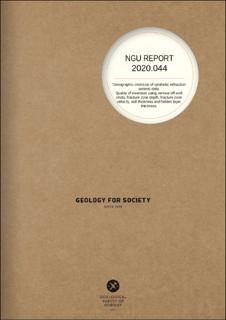| dc.description.abstract | NGU has studied tomographic inversion of refraction seismic data using the Rayfract software for years. In the present work, the quality of location and characterisation of fracture zones in bedrock as well as the quality of soil thicknesscalculation and characterisation is studied by modelling of synthetic data. The soil thickness is varied from a thin cover (1 - 5 m) to 20, 40 and 80 m. As a part of this work, the effect of distance to off-end shots outside the receiver spreadare studied. Fracture zone velocity and depth extent are varied, and alternative inversion procedures are tested.Additional inversions were performed by Impakt Geofysik (Roger Wisén) using Geogiga DW Tomo.Selected conclusions can be listed as follows: The automatic Hagedoorn inversion of refraction seismic data gives a good image of fracture zones in bedrock under limited (> 20 m) soil cover. A thicker soil cover presents challenges and demands traditional interpretation. : Due to poor resolution, thick fracture zones under a thick soil cover (> 20 m) may consist of several thinner fractured zones. : The automatic Hagedoorn inversion of refraction seismic data gives a good image of the soil layers as long as the assumptions for using the method are fulfilled (increased velocity with depth, sub-horizontal homogenous layers, large velocity contrast). : An accuracy of 90 to 95 % of the average true soil thickness can be achieved with the Hagedoorn's method and following tomographic inversion. Hidden layers of increasing thickness may reduce the accuracy to ca. 80 % of true soil thickness. However, individual variations along the profiles may be larger.: Except in the case of hidden layers, the Hagedoorn inversion may give good velocity estimations that can be used for soil material characterisation. :The DeltatV and Geogiga inversion method shows a gradual increase of the velocity with depth, and a velocity isoline must be chosen as an indicator for bedrock surface. In the present work, we were able to find a velocity isoline that gave an average total thickness within +\/. 8 % of the true soil thickness for the hidden layer models, which is very good. However, variations along the profiles varied from 78 % to 125 % of the realsoil thickness. :The gradient velocity distribution in DeltatV inversion makes soil material characterisation challenging. :At least, one off-end shot should be more than three times the soil thickness away from both ends of the receiverspread. : A low RMS error do not guarantee for a correct velocity section. : Used in the right way, the Rayfract software can be used for the location and characterisation of fractured zones in bedrock as well as mapping and characterisation of soil layers. However, hidden layers (blind zones) seem to be a problem. : In this study we have tested just a few models, and during the work the Rayfract software is upgraded with new routines. More modelling is needed to get better understanding of how automatic inversion of refraction seismic data works, also with other available software. | |

